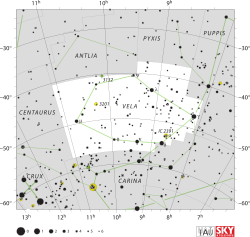WASP-19
| WASP-19 | |
 | |
| Observationsdata Epok: J2000.0 | |
|---|---|
| Stjärnbild | Seglet[1] |
| Rektascension | 09t 53m 40,0765s[2] |
| Deklination | -45° 39′ 33,0572″[2] |
| Skenbar magnitud () | 12,312 ± 0,017[3] |
| Stjärntyp | |
| Spektraltyp | G8 V[2] |
| Variabeltyp | Planetpassage-variabel |
| Astrometri | |
| Radialhastighet () | +21,41 ± 0,95[2] km/s |
| Egenrörelse (µ) | RA: -35,457[2] mas/år Dek.: +17,378[2] mas/år |
| Parallax () | 3,7516 ± 0,0090[2] |
| Avstånd | 869 ± 2 lå (266,6 ± 0,6 pc) |
| Absolut magnitud () | +5,3 |
| Detaljer | |
| Massa | 0,97 ± 0,02[4] M☉ |
| Radie | 0,885 ± 0,084[5] R☉ |
| Luminositet | 0,71 ± 0,00013[5] L☉ |
| Temperatur | 5 568 ± 71[6] K |
| Metallicitet | +0,15 ± 0,07[6] |
| Vinkelhastighet | 4,0 ± 1,0[6] km/s |
| Ålder | 9,95 ± 2,49[2] miljarder år |
| Andra beteckningar | |
| Wattle, GSC 08181-01711, 2MASS J09534008-4539330, UCAC2 12190908, UCAC3 89-92022, UCAC4 222-041382, USNO-B1.0 0443-00193111, Gaia DR3 5411736896952029568, Gaia DR2 5411736896952029568[7][5] | |
WASP-19 eller Wattle, är en ensam stjärna i den mellersta delen av stjärnbilden Seglet.[8] Den har en skenbar magnitud av ca 12,31[2] och kräver ett teleskop för att kunna observeras. Baserat på parallax enligt Gaia Data Release 3 på ca 3,75 mas,[2] beräknas den befinna sig på ett avstånd på ca 869 ljusår (267 parsek) från solen. Den rör sig bort från solen med en heliocentrisk radialhastighet på ca 21 km/s.[2]
Nomenklatur
[redigera | redigera wikitext]Beteckningen WASP-19 anger att detta var den 19:e stjärnan som observerats med en planet av Wide Angle Search for Planets.
I augusti 2022 ingick WASP-19 bland 20 system som skulle namnges av det tredje NameExoWorlds-projektet.[9] De godkända namnen föreslogs av ett team från Brandon Park Primary School i Wheelers Hill (Melbourne, Australien), ledda av vetenskapsmannen Lance Kelly och läraren David Maierhofer[10] och tillkännagavs i juni 2023. WASP-19 heter "Wattle" och dess planeten heter "Banksia", efter växtsläktena Wattle (närmare bestämt den gyllene Acacia pycnantha) respektive Banksia (närmare bestämt den scharlakansröda banksia Banksia coccinea).[11]
Egenskaper
[redigera | redigera wikitext]WASP-19 är en gul till vit stjärna i huvudserien av spektralklass G8 V.[12] Den har en massa som är ca 0,97[4] solmassa, en radie på ca 0,89[5] solradie och utsänder från dess fotosfär energi motsvarande ca 0,71[5] gånger solen vid en effektiv temperatur av ca 5 600 K.[6] Stjärnan är äldre än solen, har en bråkdel av tunga element utöver solens överskott och roterar snabbt och drivs upp av tidvatteneffekt som ökas av en jätteplanet i en snäv omloppsbana.[5]
Planetsystem
[redigera | redigera wikitext]I december 2009 tillkännagav SuperWASP-projektet att en exoplanet av typen het Jupiter, WASP-19 b, kretsade mycket nära stjärnan och med den kortaste omloppsperioden av någon transiterande exoplanet som var känd vid den tiden.[8]
(AE) |
(d) |
|||||
|---|---|---|---|---|---|---|
Se även
[redigera | redigera wikitext]Referenser
[redigera | redigera wikitext]- Den här artikeln är helt eller delvis baserad på material från engelskspråkiga Wikipedia, WASP-19, 1 december 2023.
Noter
[redigera | redigera wikitext]- ^ Roman, Nancy G. (1987). "Identification of a Constellation From a Position". Publications of the Astronomical Society of the Pacific. 99 (617): 695–699. Bibcode:1987PASP...99..695R. doi:10.1086/132034. Vizier query form
- ^ [a b c d e f g h i j k] Vallenari, A.; et al. (Gaia collaboration) (2023). "Gaia Data Release 3. Summary of the content and survey properties". Astronomy and Astrophysics. 674: A1. arXiv:2208.00211. Bibcode:2023A&A...674A...1G. doi:10.1051/0004-6361/202243940. S2CID 244398875. Gaia DR3 record for this source at VizieR.
- ^ Maxted, P. F. L.; et al. (2011). "UBV(RI)C photometry of transiting planet hosting stars". Monthly Notices of the Royal Astronomical Society. 418 (2): 1039–1042. arXiv:1108.0349. Bibcode:2011MNRAS.418.1039M. doi:10.1111/j.1365-2966.2011.19554.x. S2CID 117056033.
- ^ [a b c] Dragomir, Diana; Kane, Stephen R.; Pilyavsky, Genady; Mahadevan, Suvrath; Ciardi, David R.; Zachary Gazak, J.; Gelino, Dawn M.; Payne, Alan; Rabus, Markus; Ramirez, Solange V.; von Braun, Kaspar; Wright, Jason T.; Wyatt, Pamela (2011). "Terms Photometry of Known Transiting Exoplanets". The Astronomical Journal. 142 (4): 115. arXiv:1108.2308. Bibcode:2011AJ....142..115D. doi:10.1088/0004-6256/142/4/115. S2CID 118606598.
- ^ [a b c d e f] Maxted, P. F. L.; Serenelli, A. M.; Southworth, J. (2015), "A comparison of gyrochronological and isochronal age estimates for transiting exoplanet host stars", Astronomy & Astrophysics, 577: A90, arXiv:1503.09111, Bibcode:2015A&A...577A..90M, doi:10.1051/0004-6361/201525774, S2CID 53324330
- ^ [a b c d] Torres, Guillermo; et al. (2012). "Improved Spectroscopic Parameters for Transiting Planet Hosts". The Astrophysical Journal. 757 (2). 161. arXiv:1208.1268. Bibcode:2012ApJ...757..161T. doi:10.1088/0004-637X/757/2/161. S2CID 16580774.
- ^ WASP-19 - Wikipedia. Hämtad 2024-03-11.
- ^ [a b] Hebb, L.; et al. (2010). "WASP-19b: The Shortest Period Transiting Exoplanet Yet Discovered". The Astrophysical Journal. 708 (1): 224–231. arXiv:1001.0403. Bibcode:2010ApJ...708..224H. doi:10.1088/0004-637X/708/1/224. S2CID 119189785.
- ^ "List of ExoWorlds 2022". nameexoworlds.iau.org. IAU. 8 August 2022. Hämtad 27 augusti 2022.
- ^ https://www.facebook.com/pages/DrBradTucker/100063510852713
- ^ "2022 Approved Names". nameexoworlds.iau.org. IAU. Hämtad 7 juni 2023.
- ^ https://www.universeguide.com/star/122440/wasp19. Hämtad 2024-03-11.
- ^ Mancini, L.; et al. (2013). "Physical properties, transmission and emission spectra of the WASP-19 planetary system from multi-colour photometry". Monthly Notices of the Royal Astronomical Society. 436 (1): 2–18. arXiv:1306.6384. Bibcode:2013MNRAS.436....2M. doi:10.1093/mnras/stt1394. S2CID 55455709.
Externa länkar
[redigera | redigera wikitext]
| ||||||||||||||||
Text is available under the CC BY-SA 4.0 license; additional terms may apply.
Images, videos and audio are available under their respective licenses.





